Analyzing Physical Security: Crime Deterrence and Fire Prevention
VerifiedAdded on 2023/06/14
|6
|1504
|182
Report
AI Summary
This report delves into the critical aspects of physical security, focusing on crime deterrence and fire prevention within business environments. It examines the effectiveness of physical barriers such as CCTV cameras and chain link fences in discouraging criminal activities, emphasizing the importance of considering design features during installation. The report also outlines essential fire protocols for various operational phases, including administrative planning, general physical inspections, hazardous material handling, and alarm system functionality, highlighting the need for emergency response plans and trained personnel to mitigate potential damage. The document emphasizes the importance of integrating comprehensive security measures to protect physical assets and ensure the safety of personnel, and is available for review and study on Desklib, a platform offering a wide array of academic resources.

Running head: PHYSICAL SECURITY
Physical Security
Name of the Student
Name of the University
Author note
Physical Security
Name of the Student
Name of the University
Author note
Paraphrase This Document
Need a fresh take? Get an instant paraphrase of this document with our AI Paraphraser
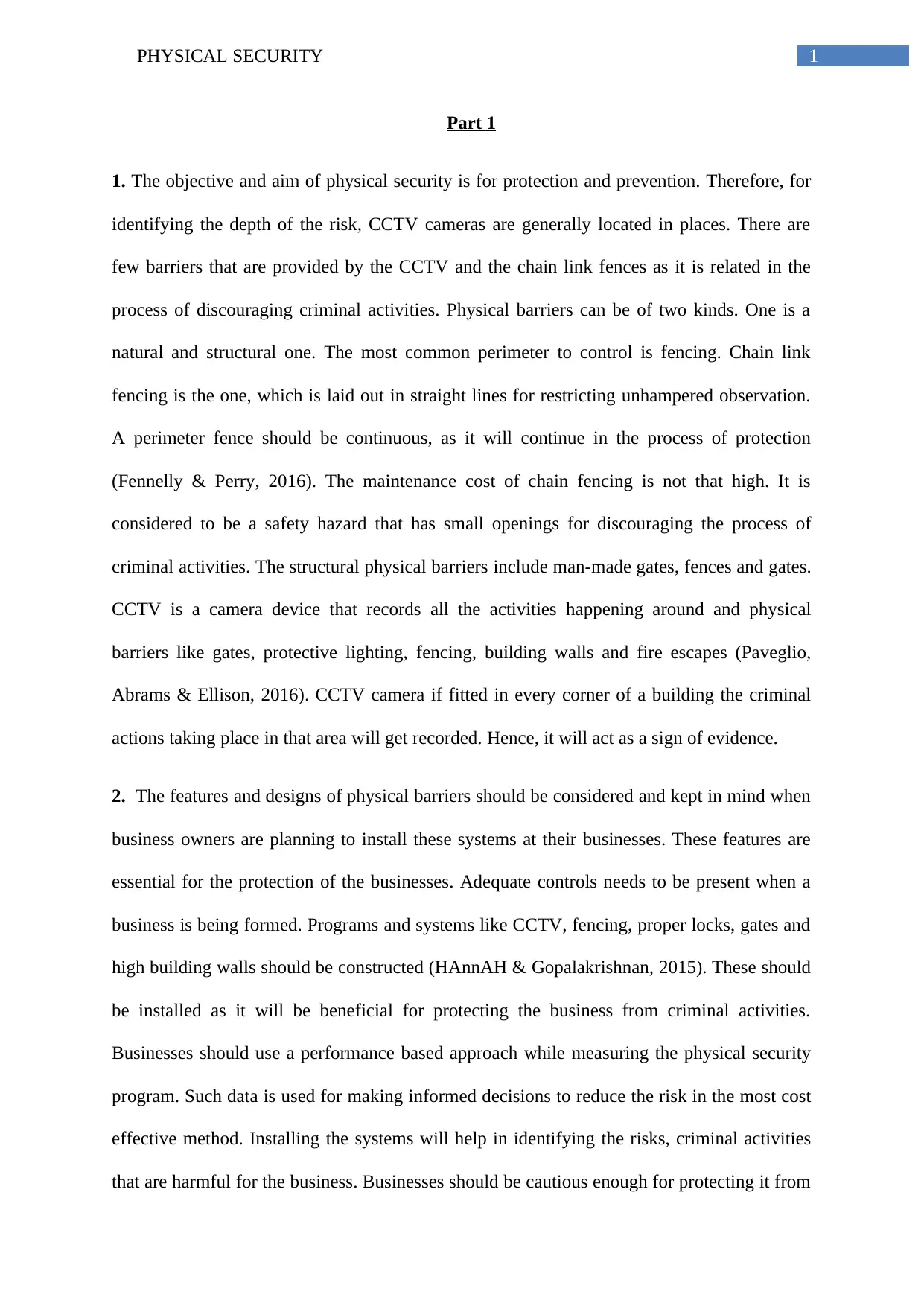
1PHYSICAL SECURITY
Part 1
1. The objective and aim of physical security is for protection and prevention. Therefore, for
identifying the depth of the risk, CCTV cameras are generally located in places. There are
few barriers that are provided by the CCTV and the chain link fences as it is related in the
process of discouraging criminal activities. Physical barriers can be of two kinds. One is a
natural and structural one. The most common perimeter to control is fencing. Chain link
fencing is the one, which is laid out in straight lines for restricting unhampered observation.
A perimeter fence should be continuous, as it will continue in the process of protection
(Fennelly & Perry, 2016). The maintenance cost of chain fencing is not that high. It is
considered to be a safety hazard that has small openings for discouraging the process of
criminal activities. The structural physical barriers include man-made gates, fences and gates.
CCTV is a camera device that records all the activities happening around and physical
barriers like gates, protective lighting, fencing, building walls and fire escapes (Paveglio,
Abrams & Ellison, 2016). CCTV camera if fitted in every corner of a building the criminal
actions taking place in that area will get recorded. Hence, it will act as a sign of evidence.
2. The features and designs of physical barriers should be considered and kept in mind when
business owners are planning to install these systems at their businesses. These features are
essential for the protection of the businesses. Adequate controls needs to be present when a
business is being formed. Programs and systems like CCTV, fencing, proper locks, gates and
high building walls should be constructed (HAnnAH & Gopalakrishnan, 2015). These should
be installed as it will be beneficial for protecting the business from criminal activities.
Businesses should use a performance based approach while measuring the physical security
program. Such data is used for making informed decisions to reduce the risk in the most cost
effective method. Installing the systems will help in identifying the risks, criminal activities
that are harmful for the business. Businesses should be cautious enough for protecting it from
Part 1
1. The objective and aim of physical security is for protection and prevention. Therefore, for
identifying the depth of the risk, CCTV cameras are generally located in places. There are
few barriers that are provided by the CCTV and the chain link fences as it is related in the
process of discouraging criminal activities. Physical barriers can be of two kinds. One is a
natural and structural one. The most common perimeter to control is fencing. Chain link
fencing is the one, which is laid out in straight lines for restricting unhampered observation.
A perimeter fence should be continuous, as it will continue in the process of protection
(Fennelly & Perry, 2016). The maintenance cost of chain fencing is not that high. It is
considered to be a safety hazard that has small openings for discouraging the process of
criminal activities. The structural physical barriers include man-made gates, fences and gates.
CCTV is a camera device that records all the activities happening around and physical
barriers like gates, protective lighting, fencing, building walls and fire escapes (Paveglio,
Abrams & Ellison, 2016). CCTV camera if fitted in every corner of a building the criminal
actions taking place in that area will get recorded. Hence, it will act as a sign of evidence.
2. The features and designs of physical barriers should be considered and kept in mind when
business owners are planning to install these systems at their businesses. These features are
essential for the protection of the businesses. Adequate controls needs to be present when a
business is being formed. Programs and systems like CCTV, fencing, proper locks, gates and
high building walls should be constructed (HAnnAH & Gopalakrishnan, 2015). These should
be installed as it will be beneficial for protecting the business from criminal activities.
Businesses should use a performance based approach while measuring the physical security
program. Such data is used for making informed decisions to reduce the risk in the most cost
effective method. Installing the systems will help in identifying the risks, criminal activities
that are harmful for the business. Businesses should be cautious enough for protecting it from
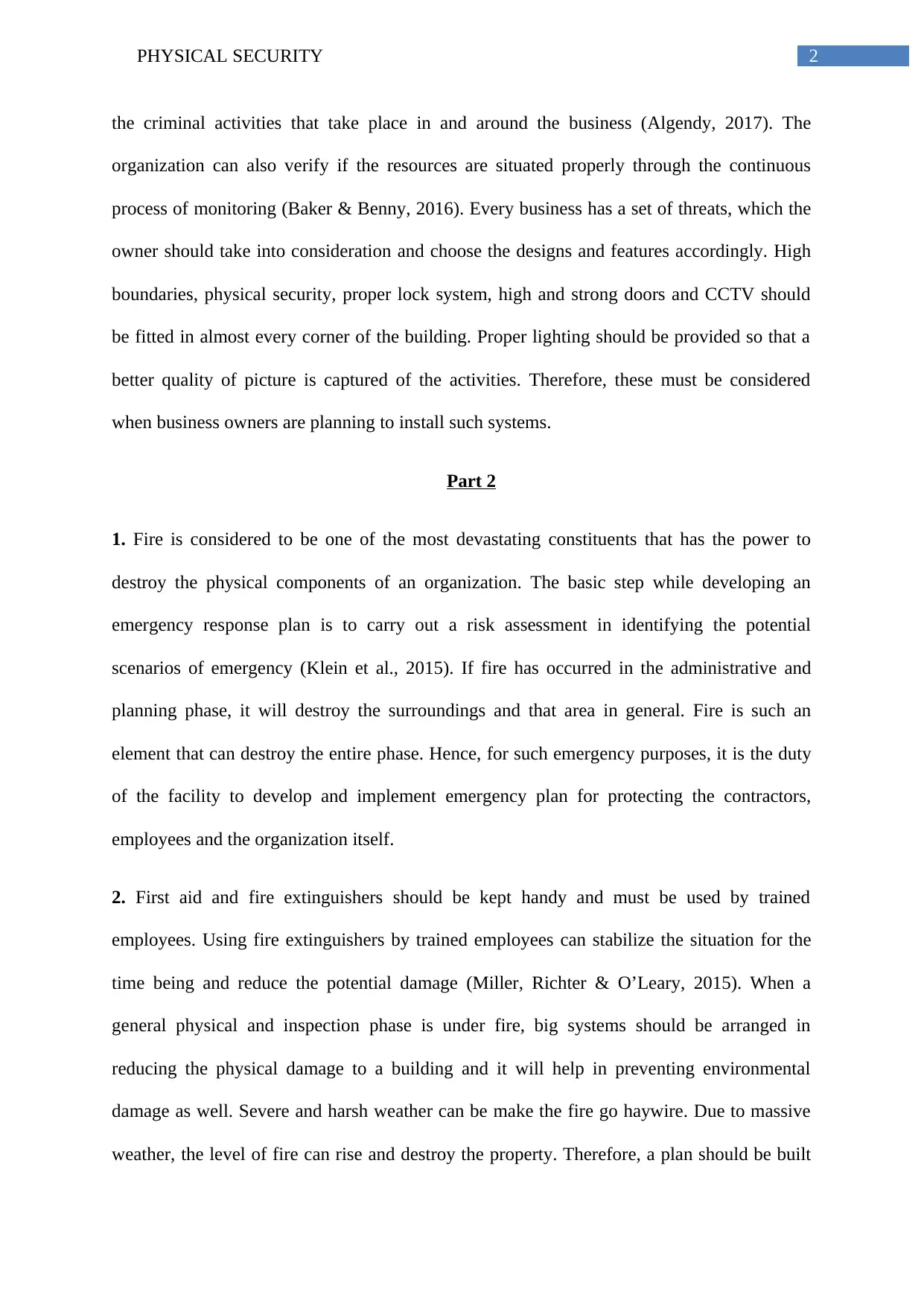
2PHYSICAL SECURITY
the criminal activities that take place in and around the business (Algendy, 2017). The
organization can also verify if the resources are situated properly through the continuous
process of monitoring (Baker & Benny, 2016). Every business has a set of threats, which the
owner should take into consideration and choose the designs and features accordingly. High
boundaries, physical security, proper lock system, high and strong doors and CCTV should
be fitted in almost every corner of the building. Proper lighting should be provided so that a
better quality of picture is captured of the activities. Therefore, these must be considered
when business owners are planning to install such systems.
Part 2
1. Fire is considered to be one of the most devastating constituents that has the power to
destroy the physical components of an organization. The basic step while developing an
emergency response plan is to carry out a risk assessment in identifying the potential
scenarios of emergency (Klein et al., 2015). If fire has occurred in the administrative and
planning phase, it will destroy the surroundings and that area in general. Fire is such an
element that can destroy the entire phase. Hence, for such emergency purposes, it is the duty
of the facility to develop and implement emergency plan for protecting the contractors,
employees and the organization itself.
2. First aid and fire extinguishers should be kept handy and must be used by trained
employees. Using fire extinguishers by trained employees can stabilize the situation for the
time being and reduce the potential damage (Miller, Richter & O’Leary, 2015). When a
general physical and inspection phase is under fire, big systems should be arranged in
reducing the physical damage to a building and it will help in preventing environmental
damage as well. Severe and harsh weather can be make the fire go haywire. Due to massive
weather, the level of fire can rise and destroy the property. Therefore, a plan should be built
the criminal activities that take place in and around the business (Algendy, 2017). The
organization can also verify if the resources are situated properly through the continuous
process of monitoring (Baker & Benny, 2016). Every business has a set of threats, which the
owner should take into consideration and choose the designs and features accordingly. High
boundaries, physical security, proper lock system, high and strong doors and CCTV should
be fitted in almost every corner of the building. Proper lighting should be provided so that a
better quality of picture is captured of the activities. Therefore, these must be considered
when business owners are planning to install such systems.
Part 2
1. Fire is considered to be one of the most devastating constituents that has the power to
destroy the physical components of an organization. The basic step while developing an
emergency response plan is to carry out a risk assessment in identifying the potential
scenarios of emergency (Klein et al., 2015). If fire has occurred in the administrative and
planning phase, it will destroy the surroundings and that area in general. Fire is such an
element that can destroy the entire phase. Hence, for such emergency purposes, it is the duty
of the facility to develop and implement emergency plan for protecting the contractors,
employees and the organization itself.
2. First aid and fire extinguishers should be kept handy and must be used by trained
employees. Using fire extinguishers by trained employees can stabilize the situation for the
time being and reduce the potential damage (Miller, Richter & O’Leary, 2015). When a
general physical and inspection phase is under fire, big systems should be arranged in
reducing the physical damage to a building and it will help in preventing environmental
damage as well. Severe and harsh weather can be make the fire go haywire. Due to massive
weather, the level of fire can rise and destroy the property. Therefore, a plan should be built
⊘ This is a preview!⊘
Do you want full access?
Subscribe today to unlock all pages.

Trusted by 1+ million students worldwide
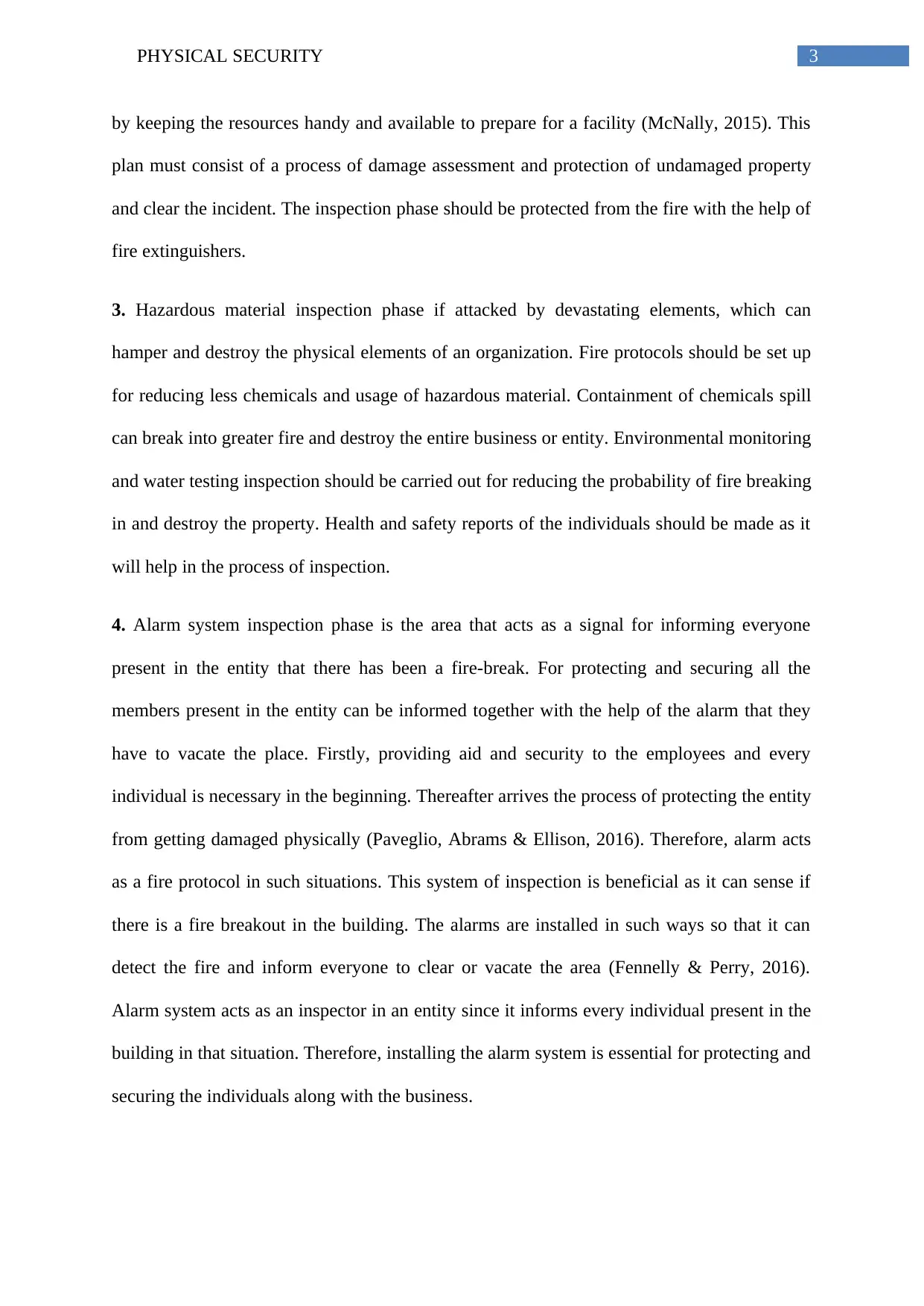
3PHYSICAL SECURITY
by keeping the resources handy and available to prepare for a facility (McNally, 2015). This
plan must consist of a process of damage assessment and protection of undamaged property
and clear the incident. The inspection phase should be protected from the fire with the help of
fire extinguishers.
3. Hazardous material inspection phase if attacked by devastating elements, which can
hamper and destroy the physical elements of an organization. Fire protocols should be set up
for reducing less chemicals and usage of hazardous material. Containment of chemicals spill
can break into greater fire and destroy the entire business or entity. Environmental monitoring
and water testing inspection should be carried out for reducing the probability of fire breaking
in and destroy the property. Health and safety reports of the individuals should be made as it
will help in the process of inspection.
4. Alarm system inspection phase is the area that acts as a signal for informing everyone
present in the entity that there has been a fire-break. For protecting and securing all the
members present in the entity can be informed together with the help of the alarm that they
have to vacate the place. Firstly, providing aid and security to the employees and every
individual is necessary in the beginning. Thereafter arrives the process of protecting the entity
from getting damaged physically (Paveglio, Abrams & Ellison, 2016). Therefore, alarm acts
as a fire protocol in such situations. This system of inspection is beneficial as it can sense if
there is a fire breakout in the building. The alarms are installed in such ways so that it can
detect the fire and inform everyone to clear or vacate the area (Fennelly & Perry, 2016).
Alarm system acts as an inspector in an entity since it informs every individual present in the
building in that situation. Therefore, installing the alarm system is essential for protecting and
securing the individuals along with the business.
by keeping the resources handy and available to prepare for a facility (McNally, 2015). This
plan must consist of a process of damage assessment and protection of undamaged property
and clear the incident. The inspection phase should be protected from the fire with the help of
fire extinguishers.
3. Hazardous material inspection phase if attacked by devastating elements, which can
hamper and destroy the physical elements of an organization. Fire protocols should be set up
for reducing less chemicals and usage of hazardous material. Containment of chemicals spill
can break into greater fire and destroy the entire business or entity. Environmental monitoring
and water testing inspection should be carried out for reducing the probability of fire breaking
in and destroy the property. Health and safety reports of the individuals should be made as it
will help in the process of inspection.
4. Alarm system inspection phase is the area that acts as a signal for informing everyone
present in the entity that there has been a fire-break. For protecting and securing all the
members present in the entity can be informed together with the help of the alarm that they
have to vacate the place. Firstly, providing aid and security to the employees and every
individual is necessary in the beginning. Thereafter arrives the process of protecting the entity
from getting damaged physically (Paveglio, Abrams & Ellison, 2016). Therefore, alarm acts
as a fire protocol in such situations. This system of inspection is beneficial as it can sense if
there is a fire breakout in the building. The alarms are installed in such ways so that it can
detect the fire and inform everyone to clear or vacate the area (Fennelly & Perry, 2016).
Alarm system acts as an inspector in an entity since it informs every individual present in the
building in that situation. Therefore, installing the alarm system is essential for protecting and
securing the individuals along with the business.
Paraphrase This Document
Need a fresh take? Get an instant paraphrase of this document with our AI Paraphraser
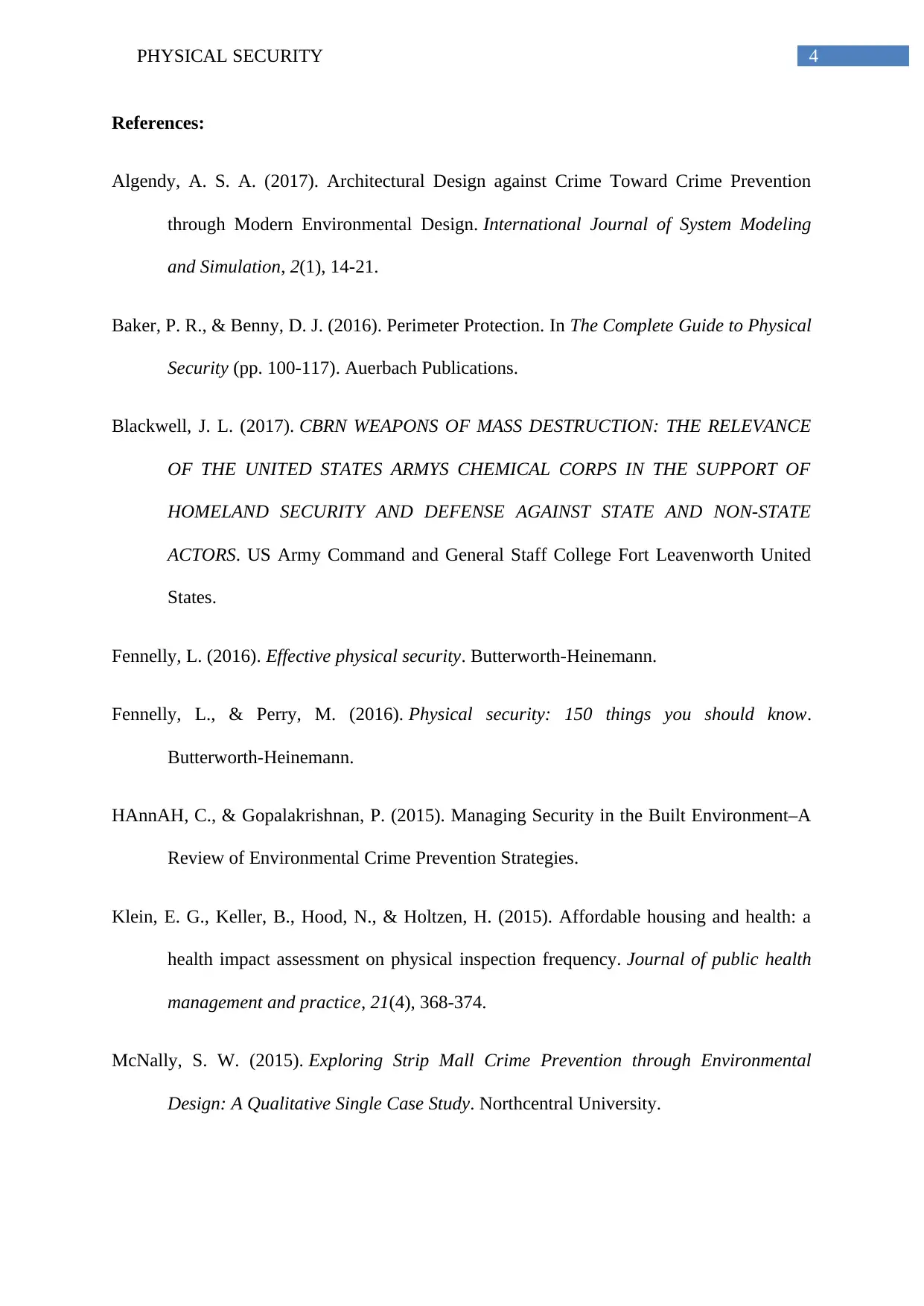
4PHYSICAL SECURITY
References:
Algendy, A. S. A. (2017). Architectural Design against Crime Toward Crime Prevention
through Modern Environmental Design. International Journal of System Modeling
and Simulation, 2(1), 14-21.
Baker, P. R., & Benny, D. J. (2016). Perimeter Protection. In The Complete Guide to Physical
Security (pp. 100-117). Auerbach Publications.
Blackwell, J. L. (2017). CBRN WEAPONS OF MASS DESTRUCTION: THE RELEVANCE
OF THE UNITED STATES ARMYS CHEMICAL CORPS IN THE SUPPORT OF
HOMELAND SECURITY AND DEFENSE AGAINST STATE AND NON-STATE
ACTORS. US Army Command and General Staff College Fort Leavenworth United
States.
Fennelly, L. (2016). Effective physical security. Butterworth-Heinemann.
Fennelly, L., & Perry, M. (2016). Physical security: 150 things you should know.
Butterworth-Heinemann.
HAnnAH, C., & Gopalakrishnan, P. (2015). Managing Security in the Built Environment–A
Review of Environmental Crime Prevention Strategies.
Klein, E. G., Keller, B., Hood, N., & Holtzen, H. (2015). Affordable housing and health: a
health impact assessment on physical inspection frequency. Journal of public health
management and practice, 21(4), 368-374.
McNally, S. W. (2015). Exploring Strip Mall Crime Prevention through Environmental
Design: A Qualitative Single Case Study. Northcentral University.
References:
Algendy, A. S. A. (2017). Architectural Design against Crime Toward Crime Prevention
through Modern Environmental Design. International Journal of System Modeling
and Simulation, 2(1), 14-21.
Baker, P. R., & Benny, D. J. (2016). Perimeter Protection. In The Complete Guide to Physical
Security (pp. 100-117). Auerbach Publications.
Blackwell, J. L. (2017). CBRN WEAPONS OF MASS DESTRUCTION: THE RELEVANCE
OF THE UNITED STATES ARMYS CHEMICAL CORPS IN THE SUPPORT OF
HOMELAND SECURITY AND DEFENSE AGAINST STATE AND NON-STATE
ACTORS. US Army Command and General Staff College Fort Leavenworth United
States.
Fennelly, L. (2016). Effective physical security. Butterworth-Heinemann.
Fennelly, L., & Perry, M. (2016). Physical security: 150 things you should know.
Butterworth-Heinemann.
HAnnAH, C., & Gopalakrishnan, P. (2015). Managing Security in the Built Environment–A
Review of Environmental Crime Prevention Strategies.
Klein, E. G., Keller, B., Hood, N., & Holtzen, H. (2015). Affordable housing and health: a
health impact assessment on physical inspection frequency. Journal of public health
management and practice, 21(4), 368-374.
McNally, S. W. (2015). Exploring Strip Mall Crime Prevention through Environmental
Design: A Qualitative Single Case Study. Northcentral University.
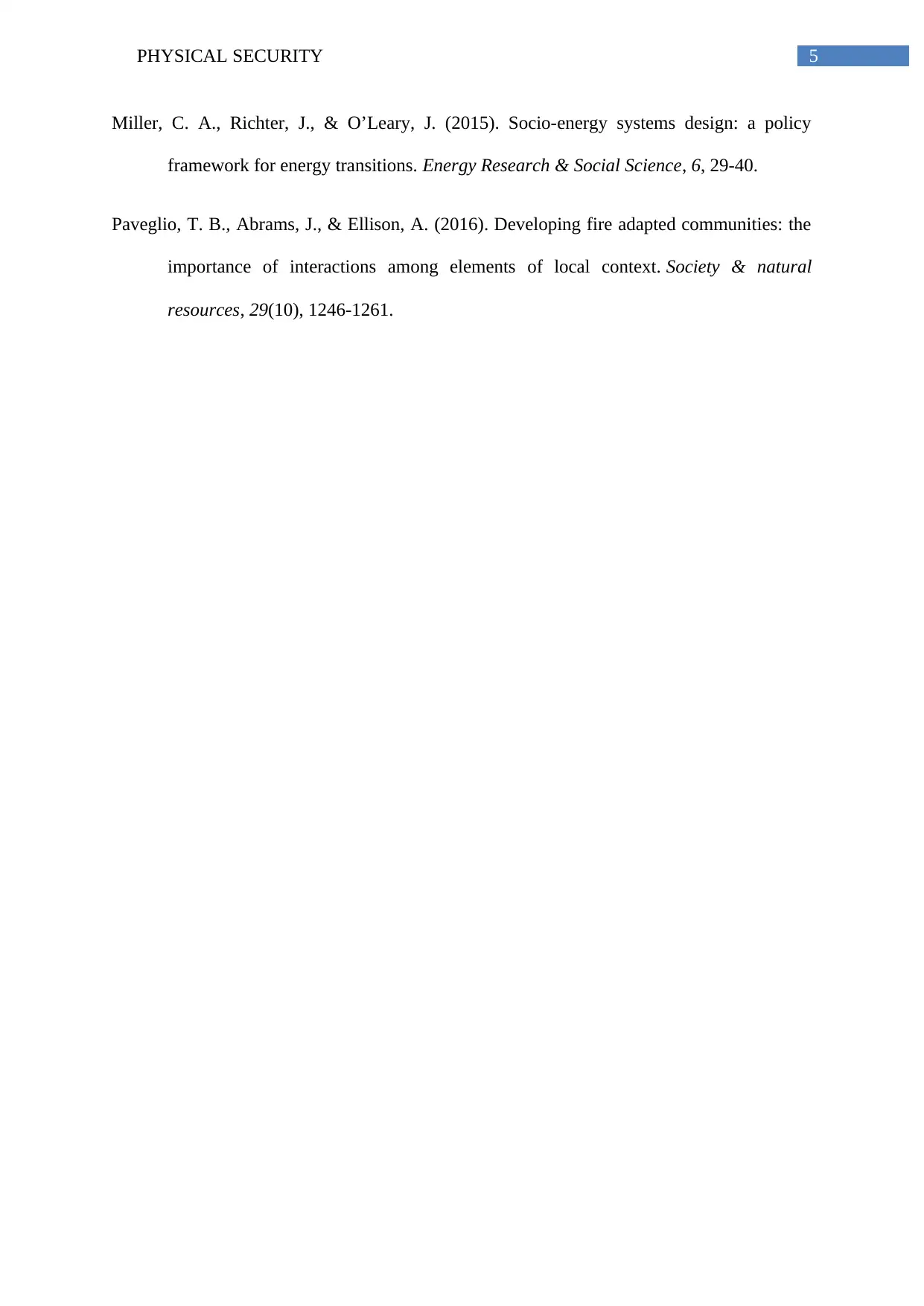
5PHYSICAL SECURITY
Miller, C. A., Richter, J., & O’Leary, J. (2015). Socio-energy systems design: a policy
framework for energy transitions. Energy Research & Social Science, 6, 29-40.
Paveglio, T. B., Abrams, J., & Ellison, A. (2016). Developing fire adapted communities: the
importance of interactions among elements of local context. Society & natural
resources, 29(10), 1246-1261.
Miller, C. A., Richter, J., & O’Leary, J. (2015). Socio-energy systems design: a policy
framework for energy transitions. Energy Research & Social Science, 6, 29-40.
Paveglio, T. B., Abrams, J., & Ellison, A. (2016). Developing fire adapted communities: the
importance of interactions among elements of local context. Society & natural
resources, 29(10), 1246-1261.
⊘ This is a preview!⊘
Do you want full access?
Subscribe today to unlock all pages.

Trusted by 1+ million students worldwide
1 out of 6
Related Documents
Your All-in-One AI-Powered Toolkit for Academic Success.
+13062052269
info@desklib.com
Available 24*7 on WhatsApp / Email
![[object Object]](/_next/static/media/star-bottom.7253800d.svg)
Unlock your academic potential
Copyright © 2020–2025 A2Z Services. All Rights Reserved. Developed and managed by ZUCOL.





